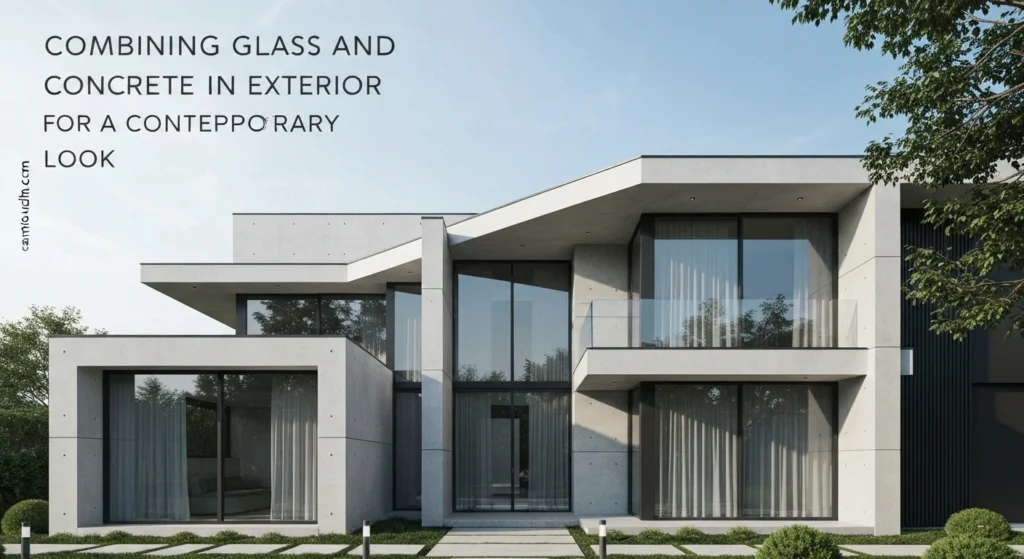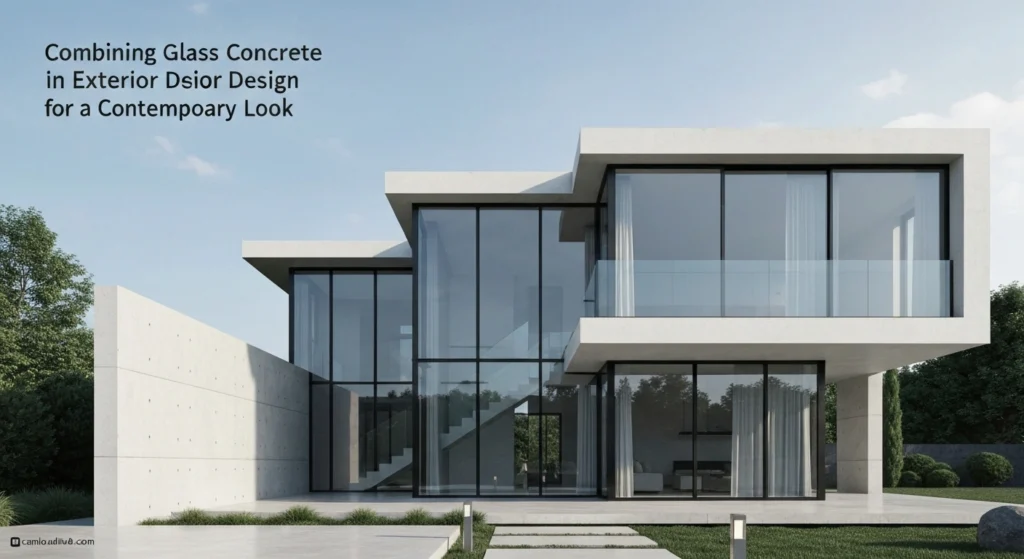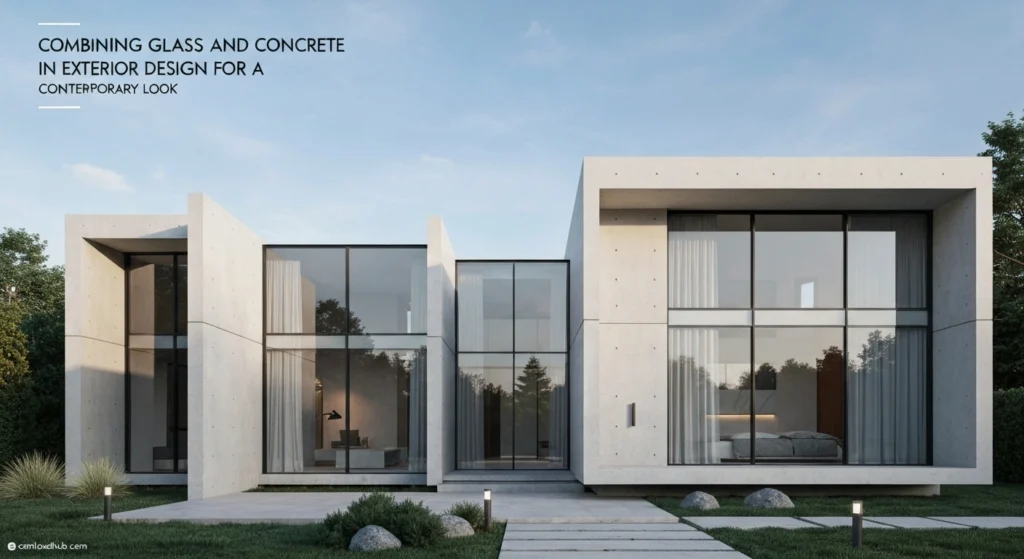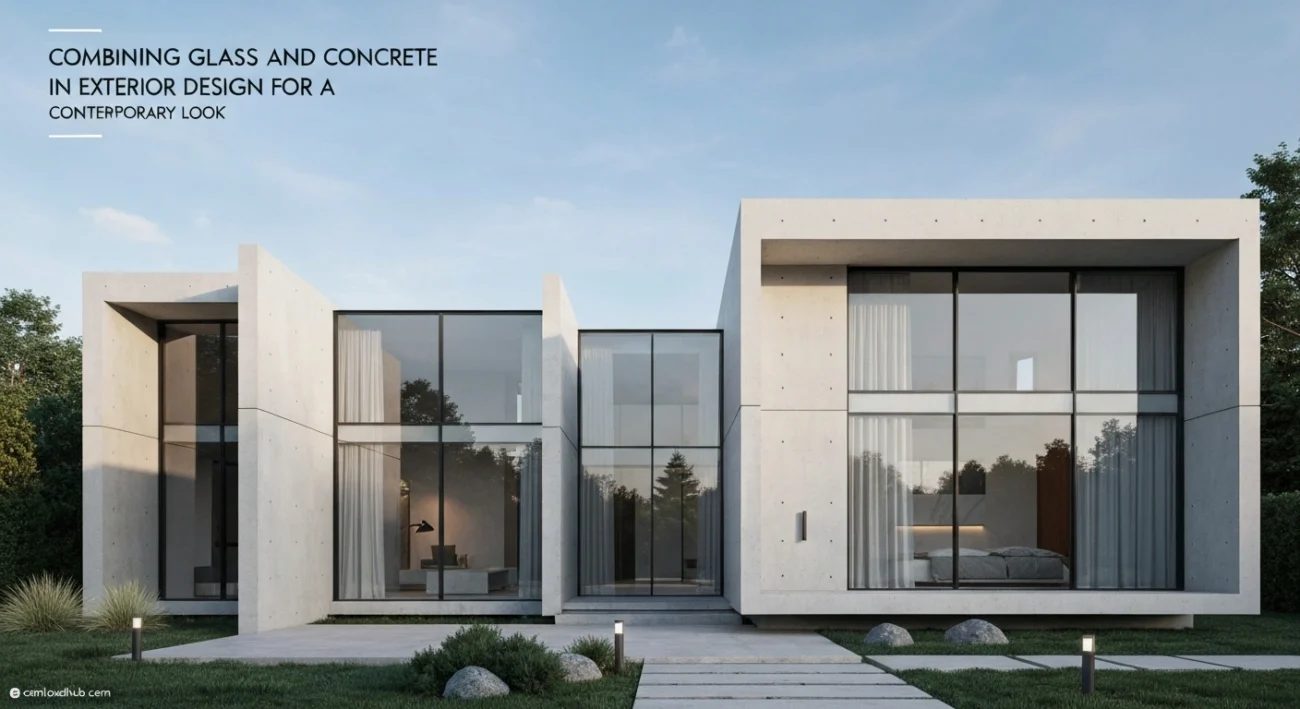The Enduring Allure of Glass and Concrete in Architecture
Combining Glass and Concrete in Exterior Design for a Contemporary Look – Glass and concrete are, individually, titans of the construction industry, each possessing a unique set of characteristics that have cemented their place in architectural history. Concrete, an ancient material continuously reinvented, provides an unmatched foundation of durability, structural integrity, and remarkable versatility. It can be molded into virtually any shape, textured to evoke different finishes, and even pigmented to expand its aesthetic range. Its raw, honest surface embodies a minimalist beauty, offering a sense of permanence and an earthy connection to the landscape. Modern concrete isn’t just about grey slabs; it’s about polished surfaces, exposed aggregates, and thoughtful formwork that elevate it to an art form.
Complementing concrete’s formidable presence is glass, a material celebrated for its transparency, lightness, and ability to connect interiors with the external world. Glass transcends the traditional notion of a mere barrier, inviting natural light to flood living spaces, offering expansive views, and dissolving the boundaries between built structure and nature. It represents clarity, technological advancement, and a desire for openness. From floor-to-ceiling windows to intricate curtain wall systems, glass transforms solid structures into luminous volumes, reflecting skies and surroundings, constantly changing with the light of day and the seasons.

When these two powerful elements are intelligently combined, the result is more than the sum of their parts. Glass and concrete exterior design leverages the inherent strengths and visual contrasts of each material, creating a dialogue between solidity and void, opacity and transparency, weight and weightlessness. This material synthesis is not just a trend; it’s a profound architectural statement that defines contemporary luxury and efficiency, offering a design language that is both robustly functional and effortlessly elegant.
Why Choose Glass and Concrete Exterior Design for a Contemporary Aesthetic?
The decision to integrate glass and concrete into an exterior design scheme is a deliberate step towards achieving a specific modern aesthetic, one that prioritizes clean lines, spaciousness, and an sophisticated material palette. This combination offers a multitude of benefits that resonate deeply with contemporary architectural principles, making it a preferred choice for those seeking to create impactful and enduring designs.
A Symphony of Contrasts: Strength Meets Lightness
One of the most compelling reasons for the enduring appeal of glass and concrete exterior design lies in its ability to orchestrate a visually stunning symphony of contrasts. Concrete, with its inherent mass and gravitas, anchors a structure firmly to the ground, imparting a sense of permanence and unyielding strength. Its often rugged or stoic presence provides a powerful counterpoint to the ethereal delicacy of glass.
Glass, on the other hand, introduces an element of lightness and transparency. It allows the eye to penetrate the building’s shell, blurring the lines between inside and out. This interplay between the opaque solidity of concrete and the sparkling clarity of glass creates a dynamic visual tension that is both captivating and harmonious. The robust, textured surfaces of concrete highlight the smooth, reflective qualities of glass, ensuring that neither material overwhelms the other but rather enhances its intrinsic beauty. This sophisticated balance is the hallmark of truly exceptional glass and concrete exterior design, resulting in facades that are visually intriguing and compositionally balanced.
Unparalleled Versatility and Customization
The design flexibility offered by combining these two materials is virtually limitless, allowing architects and designers to unleash their creative visions without constraint. Concrete, in its fluid state, can be poured into forms of any imaginable complexity, from sweeping curves to sharp, angular geometries. It can be finished in myriad ways: left raw and board-formed for a brutalist aesthetic, polished to a mirror-like sheen for urban sophistication, or textured with aggregates for a more organic feel. This adaptability means concrete can serve as a primary structural element, an accent feature, or an entire facade material, each application yielding a distinct character.
Similarly, glass is far more diverse than often perceived. Beyond standard clear panes, there are options for frosted, tinted, self-cleaning, low-emissivity (low-E), and even switchable privacy glass. Structural glazing systems can create seamless, expansive walls of glass, while smaller panes can be used to add intricate detailing or introduce varying levels of transparency and privacy.
This incredible range of choices empowers designers to meticulously craft every aspect of their glass and concrete exterior design, from the monumental to the miniscule. Whether the goal is to create a minimalist sanctuary, a bold commercial statement, or a warm residential retreat, the combined material palettes of glass and concrete provide the tools for boundless customization, ensuring each project is uniquely tailored to its context and purpose.
Bridging Indoor and Outdoor Living
At the core of contemporary living is the desire for a seamless connection with the natural world. Modern homes often prioritize open-plan layouts and an abundance of natural light, and few material combinations achieve this integration as effectively as glass and concrete. The expansive glass panels inherent in glass and concrete exterior design serve as magnificent apertures, drawing the outdoors in and transforming living spaces. They flood interiors with daylight, reducing the reliance on artificial lighting and creating a brighter, more uplifting atmosphere.
Beyond mere illumination, large tracts of glass offer unobstructed panoramic views, effectively making the surrounding landscape an integral part of the interior décor. This visual connection fosters a sense of expansion and tranquility, making small spaces feel larger and grand spaces feel boundless.
Concrete, in this context, acts as the grounding element. Its solid forms can extend from interiors to exteriors, creating pathways, patios, or retaining walls that visually and physically connect the built environment to its natural surroundings. This sophisticated interplay helps to blur the boundaries between inside and out, creating living environments that are both protected and permeable. The result is a richer, more engaging living experience where architecture is not a barrier but a bridge, inviting nature to become an active participant in everyday life through thoughtful glass and concrete exterior design.

Key Considerations for Successful Glass and Concrete Exterior Design
While the aesthetic and functional benefits of combining glass and concrete are profound, achieving truly successful glass and concrete exterior design requires meticulous planning, expert execution, and a deep understanding of both materials. There are several critical considerations that must be addressed from the conceptual stage through to construction and beyond, ensuring that the final structure is not only visually stunning but also performant, sustainable, and durable.
Structural Integrity and Engineering Excellence
The very essence of a robust glass and concrete exterior design begins with meticulous structural planning. Concrete, as a primary structural material, offers incredible compressive strength, making it ideal for foundations, columns, beams, and slabs. However, its significant weight and rigidity necessitate precise engineering to manage loads and ensure long-term stability. The integration of large expanses of glass, especially in curtain wall systems, introduces complex considerations related to wind loads, seismic activity, and the interaction between the glass façade and the concrete structure.
Engineers must carefully calculate thermal expansion and contraction differences between the two materials, designing appropriate expansion joints and flexible connections to prevent stress and cracking. The framing systems for glass elements must be robustly anchored into the concrete, requiring specialized detailing to ensure both structural integrity and airtight, watertight seals. Achieving a harmonious and safe glass and concrete exterior design relies heavily on a collaborative effort between architects, structural engineers, and experienced contractors who possess specialized knowledge in working with these challenging yet rewarding materials. Without this expertise, even the most ambitious designs risk structural compromise or premature material failure.
Thermal Performance and Energy Efficiency
One of the significant challenges in glass and concrete exterior design is managing thermal performance. While glass offers unparalleled natural light and views, it can also be a major source of heat gain in warm climates and heat loss in cold climates, impacting energy efficiency. Unmitigated glass facades can lead to uncomfortable interior temperatures and increased demands on HVAC systems.
However, modern advancements in glass technology offer sophisticated solutions. Double or triple glazing with inert gas fills (like argon or krypton) dramatically improves insulation values. Low-emissivity (low-E) coatings selectively block solar heat while allowing visible light to pass through. Solar control films and integrated shading devices (such as overhangs, louvers, or fritted glass) can further mitigate unwanted solar gain.
Concrete, conversely, possesses excellent thermal mass properties. It can absorb and release heat slowly, helping to stabilize interior temperatures and potentially reduce energy consumption, especially when used thoughtfully in conjunction with passive design strategies. When designing a glass and concrete exterior design, it is crucial to specify high-performance glass and integrate passive solar principles to create a building that is not only beautiful but also environmentally responsible and energy-efficient.
Material Selection: Beyond the Basics
The choice of specific types of glass and concrete is pivotal in defining the character and performance of an exterior design. Concrete is not monolithic; options include:
- Board-formed concrete: Leaves the impression of wood grain from the formwork, adding texture and a rustic, organic feel.
- Polished concrete: Achieves a smooth, almost reflective surface, often used for sophisticated, minimalist aesthetics.
- Exposed aggregate concrete: Reveals the stone aggregate within the mix, providing a textured, natural appearance.
- Pigmented concrete: Integrates dyes to achieve a range of colors beyond traditional grey, from warm earth tones to contemporary blacks or whites.
For glass, the options are equally diverse:
- Clear float glass: Standard transparent glass, maximized for views and light.
- Frosted or etched glass: Provides privacy while still allowing diffused light to enter.
- Tinted glass: Reduces glare and solar heat gain, often imparting color to the facade.
- Smart glass (electrochromic glass): Electronically switchable between transparent and opaque, offering on-demand privacy and solar control.
- Structural laminated glass: Offers enhanced safety and security, holding together even if shattered.
Careful selection of these materials, considering their individual properties, aesthetic contributions, and maintenance requirements, is paramount for a truly successful and intentional glass and concrete exterior design. These choices will fundamentally impact the building’s overall appearance, performance, and longevity.
Maintenance and Longevity
Ensuring the long-term beauty and functionality of a glass and concrete exterior design requires a proactive approach to maintenance. While both materials are inherently durable, they benefit from appropriate care. Concrete, particularly if left exposed, can be susceptible to staining, efflorescence (white mineral deposits), and the growth of moss or mildew in damp environments. Regular cleaning, pressure washing, and the application of high-quality sealants can protect concrete surfaces, preserving their aesthetic and preventing moisture penetration. Certain finishes, like polished concrete, may require more specialized cleaning regimes to maintain their luster.
Glass, while relatively easy to clean, still requires attention. Regular cleaning prevents the buildup of dirt, grime, and mineral deposits that can obscure views and diminish clarity. The type of glass (e.g., self-cleaning coatings) can influence maintenance frequency. Furthermore, attention must be paid to the integrity of sealants around glass panes and within curtain wall systems to prevent leaks and maintain thermal performance. By establishing a comprehensive maintenance plan, homeowners and building managers can ensure that their glass and concrete exterior design retains its original grandeur and performs optimally for decades to come, safeguarding the initial investment and the enduring aesthetic appeal.
Iconic Applications and Inspiring Examples of Glass and Concrete Exterior Design
The marriage of glass and concrete has transcended mere functionality to become a hallmark of contemporary architecture, defining distinct styles and creating iconic structures worldwide. From minimalist dwellings to grand civic buildings, the versatility and profound aesthetic of glass and concrete exterior design offer a rich palette for architectural expression.
One prominent application is in minimalist architecture, where clean lines, unadorned surfaces, and a focus on form and light are paramount. Here, raw, smooth concrete often forms the robust, monolithic base or provides stark framing, while expansive, often frameless, glass walls dissolve boundaries, creating a sense of openness and lightness. The deliberate simplicity highlights the inherent beauty of each material, allowing natural light and shadow to become primary decorative elements. This style of glass and concrete exterior design emphasizes purity and spatial clarity, creating serene and contemplative environments.
The combination also plays a crucial role in modern interpretations of Brutalist architecture, moving beyond its historically divisive public perception. While early Brutalism often embraced raw, unfinished concrete for its honesty and monumentality, contemporary designers now integrate large planes of glass to soften the material’s perceived harshness. The contrast between the imposing, textured concrete and the reflective, often transparent, glass creates a more inviting and sophisticated aesthetic. This nuanced approach to glass and concrete exterior design allows for buildings that retain the powerful presence of concrete while introducing light, views, and a refined sense of warmth, making them more approachable and aesthetically pleasing.
Furthermore, industrial chic and urban renewal projects frequently leverage the aesthetic of concrete and glass. Concrete’s raw, utilitarian qualities hark back to industrial heritage, while glass provides modern transparency and a connection to the bustling city outside. Think of converted factories or modern lofts where exposed concrete elements are juxtaposed with large, steel-framed windows or curtain walls. This style of glass and concrete exterior design celebrates the functional beauty of construction materials, often revealing structural components as part of the visual narrative. It creates spaces that feel both grounded in history and vibrantly contemporary, perfect for modern city living or dynamic commercial spaces.
These diverse applications demonstrate that glass and concrete exterior design is far more than a passing trend. It is a fundamental language in modern architecture, capable of evoking a wide range of moods and fulfilling various functional requirements. Whether creating a secluded residential haven, a commanding corporate headquarters, or a groundbreaking cultural institution, the thoughtful integration of glass and concrete allows for structures that are not only visually arresting but also deeply resonant with the spirit of contemporary design. The ongoing exploration of this material pairing continues to inspire architects to push boundaries, crafting buildings that stand as elegant testaments to human ingenuity and aesthetic sensibility.

The Future of Modern Architecture: Seamlessly Integrated Glass and Concrete Exterior Design
As we look towards the horizon of architectural innovation, the enduring partnership of glass and concrete is poised to remain at the forefront of contemporary design. The principles that have made glass and concrete exterior design so compelling a clean aesthetic, robust functionality, and a profound connection to the environment will continue to evolve, driven by advancements in material science, construction techniques, and an increasing focus on sustainability.
Future developments will likely see even more seamless integration of these two materials. Imagine intelligent glass facades that actively adapt to changing environmental conditions, regulating light, temperature, and privacy with unparalleled precision. This could include smart glass that automatically tints in response to sun exposure or self-cleaning glass that minimizes maintenance. Concurrently, concrete technology is advancing rapidly, with innovations such as self-healing concrete, ultra-high-performance concrete (UHPC) that allows for even more slender and sculptural forms, and bio-receptive concrete that supports green growth, further enhancing environmental integration.
The demand for sustainable building practices will also drive innovation in glass and concrete exterior design. Architects will increasingly employ strategies that leverage concrete’s thermal mass for passive heating and cooling, paired with advanced glazing systems that maximize daylight while minimizing energy loss. The lifecycle of materials will become even more critical, leading to greater use of recycled aggregates in concrete and more efficient manufacturing processes for glass. This focus on eco-conscious design will ensure that future structures featuring glass and concrete are not only beautiful but also contribute positively to the planet.
Ultimately, the future of modern architecture, particularly in the realm of creating compelling exteriors, will continue to rely heavily on the sophisticated dialogue between glass and concrete. Their inherently contrasting yet complementary natures offer an inexhaustible source of inspiration for designers seeking to craft buildings that are both timeless and forward-looking. The evolution of glass and concrete exterior design is a testament to architecture’s capacity for continuous reinvention, promising a future of structures that are increasingly intelligent, sustainable, and undeniably stunning, continuing to define what it means to build for a contemporary world.
Conclusion
The synergy of glass and concrete in exterior design stands as a powerful testament to the enduring appeal of modern architectural thought. This dynamic pairing delivers an aesthetic that is both profoundly grounded and remarkably ethereal, marrying the unyielding strength and versatility of concrete with the captivating transparency and lightness of glass. It’s a design choice that speaks directly to a contemporary appreciation for clean lines, abundant natural light, and an intrinsic connection to the surrounding environment.
Through thoughtful execution, glass and concrete exterior design offers unparalleled opportunities for customization, allowing each structure to tell a unique story of sophistication and purpose. While demanding expert consideration in areas like structural integrity, thermal performance, and material selection, the rewards are monumental: buildings that are not only visually stunning but also highly functional, energy-efficient, and built to stand the test of time.
Embracing this architectural duo is more than a design selection; it’s an investment in a vision, creating spaces that are both enduring in their physicality and eternal in their appeal. For those seeking to define their presence with an aesthetic that is both cutting-edge and timeless, the masterful fusion of glass and concrete in exterior design truly represents the zenith of contemporary architecture.


